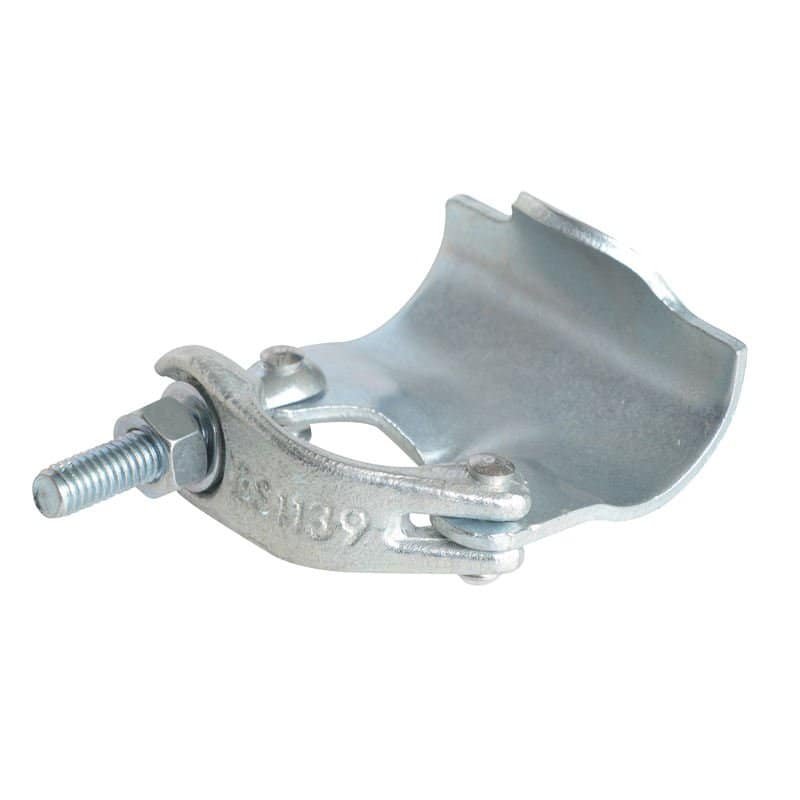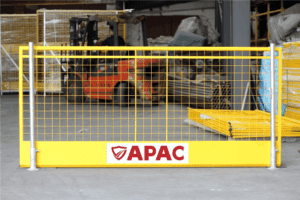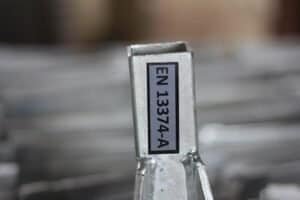Introduktion
I den här guiden kommer jag att förklara vad en putlogkoppling är, hur den fungerar, när den ska användas och hur man skaffar den. Oavsett om du är entreprenör, platsingenjör eller upphandlingschef kommer du att ha en praktisk, fälttestad förståelse som du kan tillämpa vid ditt nästa ställningsbygge.
Vad är en putlogkopplare
En putlogkoppling är en enkel (halv) koppling som används för att ansluta tvärbalken (det korta röret som bär plattformsbrädorna) till en balk (det långa horisontella röret som löper parallellt med fasaden). I traditionella murarställningar eller "putlog"-ställningar sträcker sig tvärbalken från balkbalken mot väggen; putlogkopplingen klämmer fast tvärbalken mot balkbalken, vilket förhindrar glidning eller rotation och håller plattformen stabil.
Så här ser den ut: kompakt, lättare än en rätvinklig (dubbel)koppling, med en enda klämkropp och bult. Den är konstruerad för endast ett rör, inte för att ansluta två rör samtidigt som en dubbelkoppling skulle göra.
Slutsats: putlog-kopplingen är plattformshållaren – den håller akterspegeln (och brädorna ovanpå) låsta exakt där de ska vara.
Typer av putlogkopplingar
Alla putlog-kopplingar är inte likadana. De två tillverkningsvägarna du ser:
Pressad stålkoppling med putlog
Tillverkad av stålplåt, lätt och ekonomisk. Idealisk för lätta till medeltunga fasadarbeten där volym och hastighet är viktiga.Sänksmidd putlogkoppling
Varmformad av massivt stål för högre hållfasthet och hållbarhet. Föredras där utrustning återanvänds ofta, hanteras ovarsamt eller hyrs ut.
Viktiga funktioner hos putlogkopplingar
Fäst akterspegeln vid balkramen
De hindrar akterspegeln från att krypa ner under gångtrafik och materialbelastningar.Ge arbetsplattformen sidostöd
Genom att fästa överljusen där brädorna sitter minskar de "sprickning" och studs.Hjälp till att upprätthålla lastfördelningen
Konsekvent akterspegelavstånd + positiv fixering = färre hotspots och en plattform som känns jämn och säker.
Putlog-koppling vs. andra kopplingar
Putlog vs. rätvinklig (dubbel)kopplare
- Putlog: enkel klämma för montering av liggare och akterspegel; lättare, snabbare, inte avsedd för primära fogar.
Rätvinklig: dubbelklämma för rör-rör 90° konstruktionsförbindningar; högre halkskydd och kapacitet.
Putlog vs. svivelkoppling
Putlog: fast 90°-förhållande (huvud–akterspegel), kompakt.
Vridbar: variabel vinkel för avstag och oregelbunden geometri; tyngre och dyrare.
När ska man använda vad
Använda putlog för att effektivt positionera och säkra plattformens tvärskenor till horisontella balk.
Använda rätvinklig överallt där fogen är strukturell (t.ex. liggkonstruktion enligt standard) och behöver maximal glid-/rotationsmotstånd.
Använda snurra för tandställningar och alla icke-ortogonala förbindelser.
Säkerhetsstandarder och efterlevnad
EN 74 (Europa)
Anger prestanda för ställningsrörkopplingar (hållfasthet, halksäkerhet, korrosion). Många tillverkare anger överensstämmelsesklasser för rätvinkliga/svängbara; för putstockkopplingar, verifiera tillverkarens testdata och avsedda användning – de är vanligtvis kvalificerade för montering mellan bjälklag och tvärbalk, inte primära förbindningar.OSHA (USA)
Kräver att alla kopplingar bibehåller ställningens avsedda kapacitet och stabilitet. I praktiken: välj rätt koppling för jobbet, dra åt korrekt och underhåll den.AS/NZS 1576 (Australien/Nya Zeeland)
Kräver kopplingar som är kompatibla med systemkonstruktionens belastningar och korrekta underhålls-/inspektionsrutiner.

Installation och god praxis (snabb fältguide)
Planavstånd
Ställ in avståndet mellan tvärspegeln enligt din däckleverantörs specifikationer (t.ex. 1,2 m eller tätare för brädor).Placera akterspegeln
Låt överspegeln vila där den är avsedd (mot väggen i putlog-ställningar, eller på avsedda stöd i fristående ställningar).Montera putlogkopplingen
Kläm fast akterspegeln på liggaren på innerlinjen, rikta in den vinkelrätt och dra åt med tillverkarens rekommenderade vridmoment.Kontrollera körningen
Sikta mot plattformslinjen; justera eventuella utliggare före lastning.Återdra efter första belastningen
En snabb kontroll när brädor och fotbrädor är nere förhindrar störande rörelser.
Vanliga frågor om Putlog-kopplingar
Vilken storlek på ställningsrör passar till en putlogkoppling?
Standard 48,3 mm ytterdiameter rör (kontrollera tillverkarens toleransområde).
Hur skiljer sig en putlog-kopplare från en dubbel (rätvinklig) koppling?
En putlog är en enkel klämma som används för att fästa en akterspegel vid en bärlina; en dubbel klämma kopplar ihop två rör i 90° och används för primära strukturella fogar.
Är putlog-kopplingar återanvändbara?
Ja – särskilt smidd, galvaniserad typer vid regelbunden underhåll och inspektion.
Vad är den typiska lastkapaciteten för en putlogkoppling?
Den är avsedd som en plattforms-/akterspegelsförbindning, inte en primär lastbärande koppling. Konsultera alltid tillverkarens glid-/hållfasthetsdata och din ställningskonstruktion.
Kan jag köpa putlog-kopplingar i bulk med OEM/ODM-märkning?
Ja. Många tillverkare erbjuder logotypstämpling, färgetiketter och anpassad förpackning för distributörer och uthyrningsflottor.
Kräver putlog-kopplingar specialverktyg?
Nej – vanligtvis en ställningsnyckel/skiftnyckel i rätt storlek efter bulten (t.ex. 21 mm eller 23 mm).
Hur ofta ska de inspekteras?
Vid överlämning, varje vecka (eller enligt lokalt krav), efter ogynnsamt väder och efter stöt eller överbelastning.
Är putlogkopplingar lämpliga för utomhusbruk?
Ja – välj varmförzinkad för bästa korrosionsbeständighet och håll jämna steg med rengöring och förvaring.
Kan de användas i höghusprojekt?
Ja – varhelst din design kräver montering av liggare och överliggare på fasad-/tillträdesställningar. Följ ingenjörens layout och avstånd.
Vad ska jag göra med skadade kopplingar?
Karantän och ersätt Försök inte att "räta ut" eller återanvända spruckna eller skadade kopplingar.
Slutsats
Putlog-kopplingen må vara liten, men den presterar över sin vikt. Genom att fixera tvärbalkar på bärlinor förvandlar den en rad rör och brädor till en plattform som din arbetsgrupp kan lita på. Välj rätt konstruktion (smidd kontra pressad), rätt ytbehandling (galvaniserad där det är viktigt) och rätt leverantör (bevisad kvalitetssäkring, verkliga testdata). Skapa sedan en vana att rengöra, inspektera och dra åt igen. Det är så du förvandlar delar till säkerhet – och säkerhet till produktivitet.
Letar du efter EN-testade, konsekvent tillverkade putlogkopplingar med snabba ledtider och OEM-alternativ? APAC kan hjälpa dig – be om vår senaste katalog, spårbar kvalitetssäkring för batcher och en skräddarsydd offert för din flotta.









